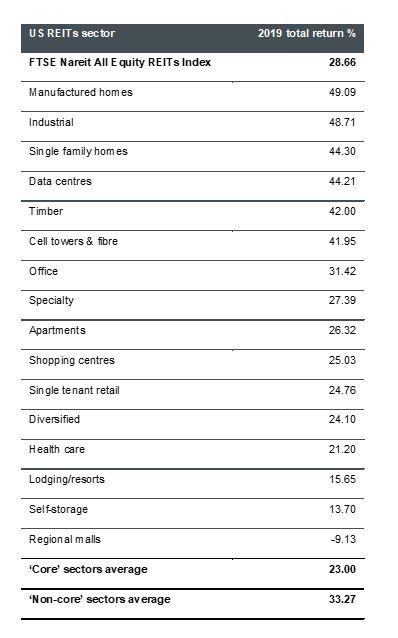
Janus Henderson Investors: Investing in real estate: Spotify or cassette tape?
Guy Barnard and Greg Kuhl from the Global Property Equities Team highlight the increasing importance of ‘non-core’ property sectors within an evolving real estate landscape.
05.02.2020 | 14:21 Uhr
Key takeaways:
- Advances in technology and changing lifestyles are creating headwinds for ‘core’ office and retail sectors
- ‘Non-core’ property sectors are projected to have better potential to deliver growth and total returns over the medium term
- Listed REITs may offer benefits to investors looking to add property to diversify returns in a balanced portfolio
Our urban and suburban landscapes are dotted with a myriad of buildings of all types. Many of these buildings fall into one of five ‘core’ property sectors; industrial/logistics, apartments, office, shopping centres/regional malls and lodging/resorts. Historically, most investors’ exposure to real estate has been focused on these ‘core’ property sectors. Retail and office combined typically account for more than half of most ‘core’ property fund holdings.
While in the past these ‘core’ sectors have provided attractive risk-adjusted returns to investors, we believe structural headwinds in office and retail justify exploring other types of real estate investments that have the potential for superior performance.
Office and retail are challenged
Office properties require significant levels of ongoing maintenance capital expense in order to maintain competitive positioning, which may consume up to 30% of asset level income over time, resulting in a reduction of investment returns. At the same time, office demand is stagnating in many markets as tenants strive for more efficiency and flexibility, ie, leasing the minimum possible space per employee and demanding shorter lease contracts.
Brick-and-mortar retail arguably faces a greater challenge than office. Given the broad-based growing adoption of online shopping, retail space requirements are shrinking significantly, evidenced by the 9,302 retail stores, which closed in the US in 2019 (up 59% from 2018, according to Coresight Research). This is leaving many landlords in an unfortunate competitive position with little or no pricing power and rendering some retail properties obsolete.
Our belief is that ecommerce penetration rates will continue to rise in most developed markets, boosted by the growing share of consumer spending, which will come from a generation fully embracing online shopping, as highlighted in the following charts.

Source: eMarketer, Prologis, Evercore ISI Research company surveys as at February 2019.
Not all property sectors are equal
Real estate investment trust (REIT) markets, which tend to be forward looking, have already acknowledged that “a rising tide will not lift all boats’’. For example, while US REITs delivered a pleasing total return of 28.66% in 2019, they also exhibited the second highest year of intra-sector return dispersion in the past fifteen years (2009 was the highest over that period)1.
REIT returns vary by sector

Source: Nareit as at 31 December 2019 in USD total return terms. ‘Core’ sectors include industrial, apartments, office, shopping centres/regional malls and lodging/resorts. Past performance is not a guide to future performance.
‘Non-core’ the way forward?
The confluence of technological advance and evolving demographics has created an unavoidable force that we believe will continue to reshape the commercial real estate landscape for years to come.
While we constantly search for mispriced securities in all property sectors, our forward-looking analysis indicates that ‘non-core’ real estate sectors look positioned to deliver superior growth and total returns versus 'core' property sectors over the medium term and as such, the sector level performance exhibited in 2019 may be only the latest chapter in a lengthy story. Just as most consumers no longer listen to music on cassette tapes, watch movies on VHS, or talk to friends on landline telephones, real estate investors may want to reconsider building their allocations solely around the ‘core’ sectors.
Instead, we think specialised property sectors with attractive supply/demand characteristics like manufactured housing communities, professionally managed single-family rentals, data centres, and cell towers, to name a few, are presenting more attractive investment currently and in the years ahead.
Conclusion
We believe that listed REITs offer the most comprehensive, cost effective, and investor-friendly access to emerging property sectors that are likely to be the darlings of tomorrow. Superior access to specialty property types, which now comprise around 60% of US REITs’ market capitalisation, is one important reason why listed REITs have delivered an annualised return of 10% since the dawn of the “modern REIT era” in the mid 1990s.2 Like private core real estate funds, US REITs have also historically delivered returns with generally lower correlations to traditional assets classes such as equities and bonds3. We expect the divergence in return between ‘core’ and ‘non-core’ property sectors to continue, or even widen, over the coming years as the needs for and uses of real estate continue to evolve.
Notes:
Past performance is not a guide to future performance.
1 Source: Nareit, Morgan Stanley Research, REIT outlook North America: ‘Narrow focus for 20/20 vision’, 18 December 2019.
2 Source: Nareit - US REITs market capitalisation as at 31 December 2019. US REITs performance - Bloomberg Real Estate Investment Trust Index in USD terms from 31 March 1994 to 31 December 2019.
3 Nareit, Factset, REITWatch January 2020, FTSE Nareit All Equity REITs Index: comparative total return correlation versus various US equity and bond indices from December 1989 to December 2019.




Diesen Beitrag teilen: